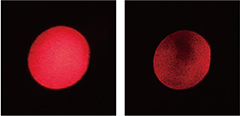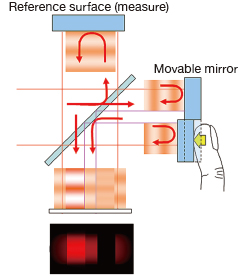Interferometers
Guide
Experiment Method
After assembling an interferometer, to understand the features of the interferometer, having a simple experiment before entering a full-scale experiment is suggested.
From which, you can acquire a lot of information that cannot be obtained from textbooks or math formulas.
The following four experiment methods are simple and do not require any special tools.
Fringe Control
To change the direction of interference fringes, adjust the elevation and azimuth of a mirror.
To increase spacing between fringes and make even brightness on the entire surface, further make ultra fine adjustment.
The number of fringes indicates the crossing angle of the two beams.
When the number of fringes is zero, the two beams are completely parallel.
Then, to increase the number of interference fringes, rotate the mirror.
The crossing angle can be found from the number of interference fringes.

Phase Shift
When no fringes are present, if you lightly touch (press) the mirror on one side toward the direction of the optical axis, the brightness of the interference fringes changes drastically. Brighter interference fringes indicate that the phases of two beams match, and darker fringes indicate that the two beams diminish each other because their phases are different by half the wavelength.
When moving for half the wavelength, the brightness and darkness alternate.


Air Turbulence
If you slowly insert your hand from underneath one optical path of an interferometer, you can observe fringe deflection. This is because the air is warmed by the temperature of the palm, changing the refractive index of the air like a heat haze. Fringe deflection is greater near the palm due to heat dissipated from the palm.

Distortion of the Mirror
If you tighten and slightly loosen the mirror retaining screw (set bolt) that fixes the mirror on a mirror holder of an interferometer, you can observe changes in the shape of interference fringes. When the screw is strongly tightened, the mirror is distorted by the stress, resulting in distortion of the flat surface of the reflector.
The distortion is too minute for humans to detect, but is observed as a drastic change in fringes in the interferometer.




